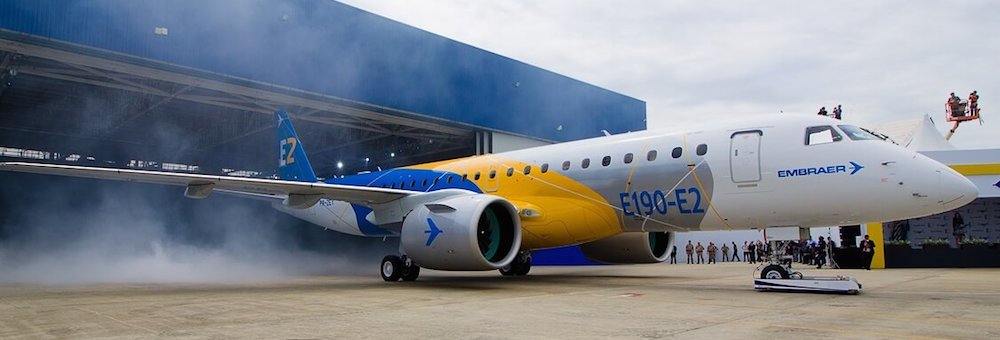Widerøe ends Dash 8-only era, adds world’s 1st Embraer E190-E2

The Brazilian plane manufacturer, Embraer, and Scandinavia’s largest regional airline, Widerøe, celebrated the delivery of the first production E190-E2 jet on April 4, 2018. The Norwegian airline will start flying the new aircraft on domestic routes later in April, 2018, becoming the first airline in the world to use the E190-E2 on commercial flights.
“The E190-E2 is an impressive aircraft. It is the ideal airplane for Widerøe as we introduce jets for the first time in the company’s 84-year history,” said Stein Nilsen, CEO of Widerøe, celebrating the delivery of the first E2 jet on April 4, 2018.
The Norwegian airline has contracted for up to 15 E-Jets E2s – three firm E190-E2 orders and purchase rights for an additional 12 E2s. The total value of the order is approximately $873 million if all rights are exercised.
The E190-E2 jet is the next generation environmentally friendly aircraft which, according to the airline, “will contribute to a sustainable future for Norwegian aviation and for Widerøe”, as it remains committed to IATA’s goal of zero emissions by 2050.
“I believe everyone is going to celebrate with, as the launch customer, the fact that we are the first airline to fly the world’s most environmentally-friendly airplane. With the lowest noise and emissions among aircraft in its category,” said Nilsen.
Embraer has also welcomed Widerøe as its new customer. “This is a historic day for the E-Jets program and for Embraer. The delivery of this E2 marks a continuation of a real success story in global aviation,” said John Slattery, President and CEO of Embraer Commercial Aviation.
Widerøe announced first routes with the E190-E2 jet back in October 2017. The airline’s new fleet family member is set to take off from Bergen Airport at Flesland, Bergen, (BGO) towards Tromsø Airport at Langnes, Tromsø, (TOS) on April 24, 2018.
The E190-E2 is the first of three new-generation aircraft seating from 80 to 146-seat E-Jets to be introduced through 2021. The E-195 E2 is scheduled to enter into service in 2019, while the E175-E2 in 2021. Widerøe’s E190-E2 is configured with 114 seats in a single-class layout.
Aside of the first delivery of the E2 jet, the Norwegian carrier currently operates a fleet of 42 aircraft, all Bombardier Dash 8 turboprops: 21 Dash 8-100s, three Dash 8-200s, seven Dash 8-300s, and 11 Dash 8-400s.
About the E190-E2 jet
The E190-E2 features new Pratt & Whitney’s Geared Turbofan ultra-high bypass ratio engines (the PW1900G), new aerodynamically-advanced high-aspect ratio distinctively-shaped wings, improved systems and avionics, 4th generation full fly-by-wire flight controls, and new landing gear.
Compared to the first-generation E190, 75% of the aircraft systems are new. Embraer recently announced some final flight tests results confirming the E2 as the most efficient single-aisle aircraft on the market. In fuel consumption, the E190-E2 proved to be 1.3% better than originally expected, a 17.3% improvement compared to the current-generation E190.
The E190-E2 has the lowest level of external noise and emissions in the segment. Flight test results also confirmed the jet to be better than its original specification in takeoff performance. The aircraft’s range from airports with hot-and-high conditions increases by 600 nm compared to current generation aircraft. Its range from airports with short runways also increases by more than 1,000 nm allowing the aircraft to reach destinations like Moscow and the north of Africa.
The E190-E2 will also have the longest maintenance intervals among single-aisle aircraft with 10,000 flight hours for basic checks and no calendar limit for typical utilization. This means an additional 15 days of aircraft utilization over ten years compared to current generation E-Jets. Furthermore, pilots of current-generation E-Jets will need only 2.5 days of training and no full flight simulator to be qualified to fly an E2.
Source – AeroTime

